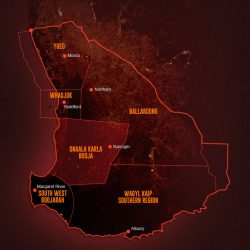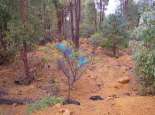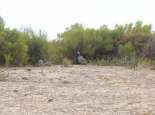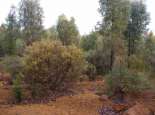About the Gnaala Karla Booja Region
 The Gnaala Karla Boodja region refers to the Noongar language or dialectical groups of the Binjareb/Pinjarup, Wilman and Ganeang. Towards the east of the Gnaala Karla Booja region is the Balladong region and down south is the Wagyl Kaip region.The Gnaala Karla Booja region encompasses the towns of Capel, Donnybrook, Balingup, Wickepin, Narrogin, Williams, Mundijong, Kwinana, Brookton, Pingelly, Wagin, Harvey, Collie, Pinjarra, Mandurah and Boddington. The approximate size of the Gnaala Karla Boodja region is 30424.531 sq.km
The Gnaala Karla Boodja region refers to the Noongar language or dialectical groups of the Binjareb/Pinjarup, Wilman and Ganeang. Towards the east of the Gnaala Karla Booja region is the Balladong region and down south is the Wagyl Kaip region.The Gnaala Karla Booja region encompasses the towns of Capel, Donnybrook, Balingup, Wickepin, Narrogin, Williams, Mundijong, Kwinana, Brookton, Pingelly, Wagin, Harvey, Collie, Pinjarra, Mandurah and Boddington. The approximate size of the Gnaala Karla Boodja region is 30424.531 sq.km
Wedjellah and Noongar – we are all here together, this is our country, Noongar-Wedjellah. We welcome you here to our country, this is our Moort, you are our Gnaala Moort – we are family, we are one – that Moort means we are one.
Noongar Elder, Mrs Janet Hayden in Gnaala Karla Booja in Working in Partnership with Industry and Government, August 2012
There are a number of significant sites in Gnaala Karla Booja, including Boyagin Rock (near Brookton) and the Pinjarra Massacre site. In Gnaala Karla Booja, you can also find the caves of mythological beingsm ceremonial sites and artefacts.
Boyagin Rock
Noongar people have a “Back to Boyagin” day to catch up with moort – family/relations. Our moort bring their chairs and tables, barbecues, cameras, footballs and walking shoes. We moort sit around and wangkiny – talk and yarn, walk to the top of Boyagin Rock – our Noongar moort have been doing this for years. The kurrlongurr – children play games. Noongar have many stories to tell about our experiences at Boyagin Rock and one thing is for sure, we never stay there after dusk because it is a very wirrin (spiritual) place. Noongar people also believe that this is the last resting or sleeping place of the Waugal.
My husband (Andy Collard) said that in that rock (Boyagin Rock) there is a big Waargle, water snake and when it wound itself round and round it looked like a big tyre. So he’s there and I think it’s sacred, it means water to us. Old Waargle is sacred to us and you must never kill it or harm it in any way.
Noongar Elder Janet Collard, RIP in Harben & Collard, ‘Recording Traditional Knowledge‘ 2005
Noongar people have cultural and spiritual links with the gungurru plant; Noongar ancestral knowledge indicates that this plant originated from Boyagin Rock. Traditional Noongar people chewed the bark from some trees to make soft rope. Boyagin is also an important area because it holds a wonderful diversity of eucalypts, wandoo and powderbark wandoo.
Pinjarra Massacre
The Pinjarra Massacre, otherwise known as the Battle of Pinjarra, was one of Western Australia’s bloodiest and darkest days. On 28 October, 1834, a party of men, led by Governor James Stirling, surrounded the camp of the Bindjareb Noongar people in Pinjarra and opened fired, killing up to 30 moort – family as they fled for cover.
The Pinjarra Massacre or ‘Battle of Pinjarra,’ as the history books had it recorded, turned the tide of Noongar resistance to colonial invasion around the Swan River and Murray River region.
Barragup Mungah
In Gnaala Karla Booja the Barragup mungah – fish weir on the Serpentine River has long been recognised by local Noongar people as amongst the most important traditional meeting places for Noongar from the Swan, Peel and Darling Ranges areas.
… this country is our country, not one, not two but all of us that are here today, this is our land and we can be proud of it. As a child, I wondered all around these waterways with my family, we fished the area, we hunted, we got berries and whatever else – we survived where other people couldn’t. We got used to other people coming here from all other country areas and we fed them with fish because we knew how to catch the fish. We became pretty famous for this and we still are – we still do it.
Noongar Elder Harry Nannup in Gnaala Karla Booja in Working in Partnership with Industry and Government, August 2012
Trade
Much of the trade that took place between the different Noongar groups was dependent on the six Noongar seasons. A well known Noongar meeting place for trade was in Pinjarup Noongar booja. It was known as the Mandura (Mandurah derives its name from this activity), which was a type of market where goods were exchanged amongst Noongar people during the Bunuru or summer season.
The Gnaala Karla Booja claim for Native Title was made in September, 1998.
Gnaala Karla Booja Contact Details
Gnaala Karla Booja Regional Development Coordinator
South West Aboriginal Land and Sea Council 1490 Albany Highway Cannington WA 6987
(08) 9358 7400
reception1@noongar.org.au


